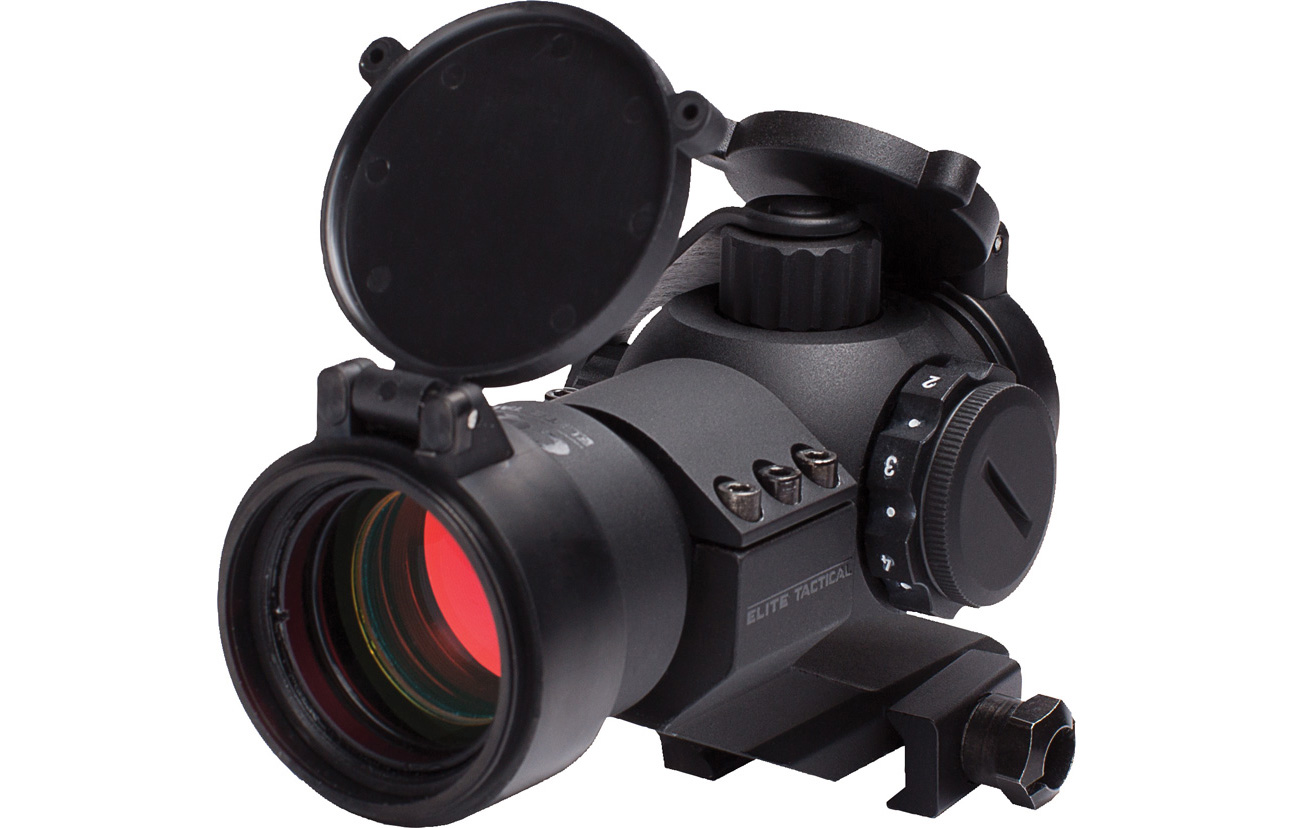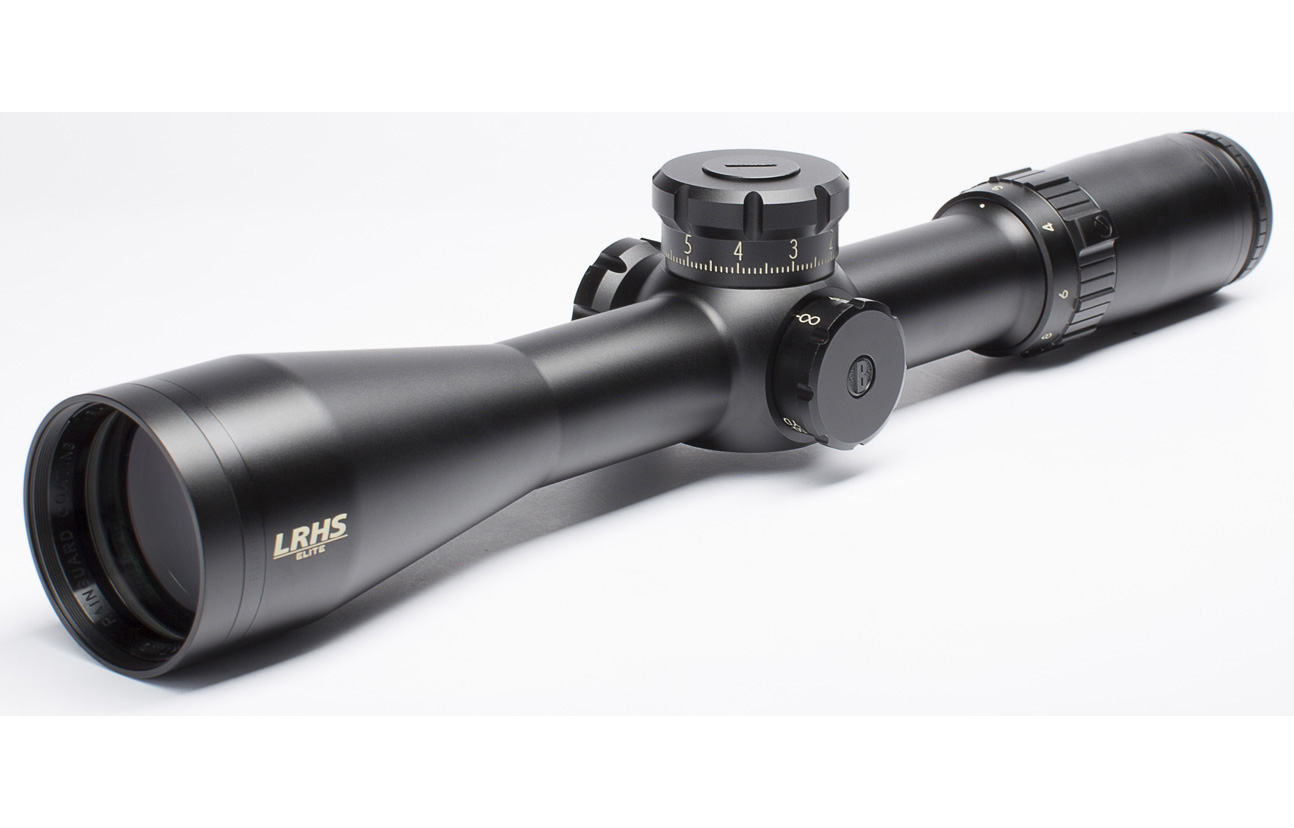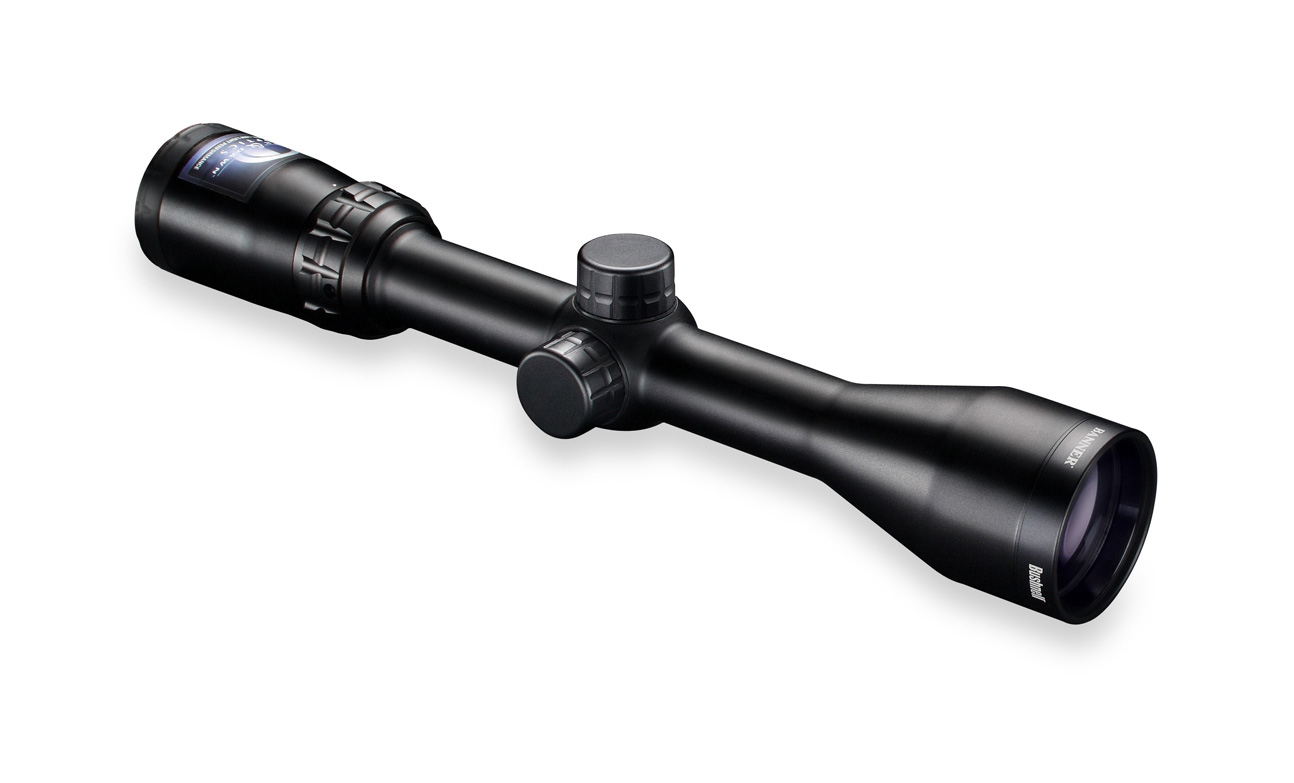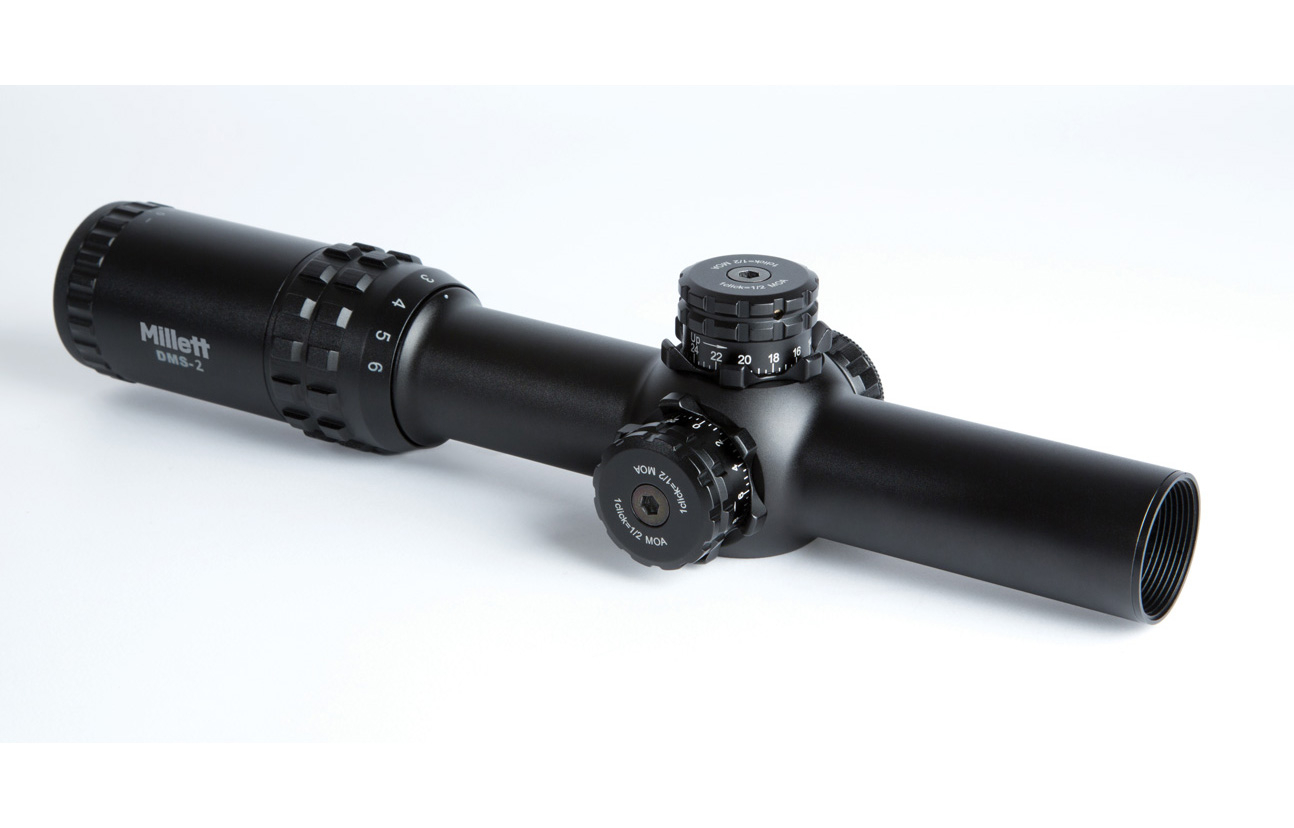NASGW— Optics, Sights and Scopes
Coming up with better optics for shooters annually must be a headache for engineers. Examine a top-end scope and you might wonder, as I do, how it could be improved. But the glass, coatings, variable power mechanisms and adjustments in even mid-level scopes today trump the best available a few years ago. Incremental improvements, like compounding interest, add up. Still, you needn’t buy them all.
Rifle-scopes have grown in size and magnification. That evolution doesn’t make them better, just different and more costly. You may find such scopes useful, depending on what you want a scope to do. Mechanical and cosmetic tweaks labeled “tactical” complement rifles in police cruisers and those peddled to civilians steeped in “black ops” lore. Stripped down, many are just like scopes on deer rifles. Beyond the marketing, though, lies real innovation. I sought the latest at the annual National Association of Sporting Goods Wholesalers (NASGW) show in Dallas.
Advertisement — Continue Reading Below
Held in late fall, NASGW offers a glimpse at what should next appear in January at the SHOT (Shooting Hunting and Outdoor Trade) Show. Unlike SHOT, a juggernaut with more than a dozen miles of aisles and an apocalyptic pace, the NASGW event is of modest size and has an easy rhythm. I came away with this preview.

Burris
This Colorado optics company has more new products for 2014 than you might have seen from the entire industry before AR-15 became a household word. The XTRII Xtreme Tactical Riflescope belongs on ARs. But its features beg other applications, too. All variations have illuminated reticles and generous (to 4.25 inches) eye relief, 25-percent thicker tubes and dual-spring adjustments. The 1-5×24 is a rear-focal-plane sight with a 30mm tube. The 2-10×42, 3-15×50, 4-20×50, 5-25×50 and 8-40×50 have 34mm tubes and front-focal-plane design for fast, accurate ranging with their mil-dot and F-Class MOA reticles. Burris gave the 1.5-8×28 both front- and rear-plane reticles. The black mil-dot marks stay in the front plane, changing in size as you dial magnification up and down. The illuminated circle-dot reticle in the field’s center remains the same size. The five-times magnification span of these scopes makes them particularly versatile. An elevation range of at least 90 minutes for all but the 8-40x ensures you’ll have plenty of adjustment for those distant targets. Turret-mounted focus/parallax dials of course!
“We’ve dropped the Diamond and Signature Select series from the Burris line,” explained Burris’ Patrick Beckett, “and replaced them with our Veracity series. It comprises four 30mm scopes with five-times magnification.” The 2-10×42, 3-15×50, 4-20×50 and 5-25×50 all feature your choice of Ballistic E1 or Ballistic E1 Varmint front-plane reticles. Their PTC (progressively thick crosshairs) nix the problem some shooters have with front-plane design—that the wires get thicker as you boost power and thinner as you decrease it, the opposite of what you ordinarily want in the field. The Burris alternative yields a bold reticle at the low end, and is fine enough at high magnification for those long shots. You can choose E1 Hunter or target-style knobs. Like the XTRII line, Veracity scopes have “True Zero Stop” dials that give you lots of adjustment range but easy return to zero. Weight? Well, the lightest sight in both these stables scales over 21 ounces. But optically, mechanically and cosmetically they’re superb riflescopes!
Advertisement — Continue Reading Below
Some years ago, when I tested the fires Burris Eliminator laser range-finding scope, I found it as accurate as advertised, easier to use than it appeared—and as bulky as expected. Several iterations later, the Eliminator III has more power, sleeker form and more sophisticated innards. It’s also noticeably lighter and more compact. The original 4-12×42 and subsequent 3.5-10×42 are both gone, replaced by a 4-16×50 of about the same proportions. Now there’s a 3-12×44 that, at 13.5 inches, is 2 inches shorter. At under 29 ounces, it weighs a couple of ounces less. The laser’s reach is listed as the same: 1,200 yards to reflective objects, 750 yards to deer. Both versions have front-sleeve parallax adjustment and an internal inclinometer to compensate for vertical shot angle. Wind drift for your programmed load appears as you aim with the lighted dot. Multiple black dots help you hold correctly into the wind. The Eliminator III needs no rings and attaches easily to a Weaver or Picatinny rail. Ambidextrous activator buttons let you keep your hands on the rifle when you spot your target.
The Burris C4 (cartridge-calibrated custom clicker) costs as little as $299 but performs like much more costly scopes. The 3-9×40 and 4.5-14×42 power ranges come in both 1-inch and 30mm tubes. The defining feature of all versions is an elevation dial programmed to the trajectory of your bullet, so you can hold center at any range. A couple of “stock” 1-inch C4 3-9x40s are engineered for hunting loads in .270 and .30-06. If you prefer one of several gazillion other rounds, no worries! Just send a ballistic summary of your favorite load and Burris will build a custom dial for it. The C4 wears a “wind map” (also matched to your load). It’s a tag on the outside of the objective bell that shows bullet drift in 100-yard increments to 600 yards. Quarter-minute dials feature Burris’ dual-spring, steel-on-steel support inside. I’m pleased Burris kept these scopes compact and light enough for lithe hunting rifles. The 1-inch 3-9x measures 12.2 inches and weighs 13 ounces. By the way, the C4 is a re-launch of a 2013 introduction that performed beautifully but in the market frenzy of the time got too little attention. It certainly deserves more!
A variation of the new C4 series is the AR, actually a pair of 1-inch 4.5-14×42 scopes. Both 18-ounce sights have the trajectory-matched elevation dial and wind map of the C4, and a hash-marked reticle that helps you hold off for wind. In addition, though, they feature a parallax adjustment ring. True to its name, the Burris AR is intended for a specific platform, so it’s programmed for two common AR chamberings: .223 and .308 (5.56mm and 7.62mm). Another new scope for that application is the Burris MSR (modern sporting rifle). It has a Ballistic Plex reticle “configured for your favorite tactical loads.” The 3-9×40 includes cartridge-specific variations for the .22LR and .223. The 4.5-x14x42 for the .223 has a front-end-adjustable objective. All three scopes feature 1-inch tubes.
Advertisement — Continue Reading Below
Also for the AR-15, Burris has announced the AR-1X, a prismatic sight that clamps with one nut to a Weaver or Picatinny rail. Add a ring if you wish to add an AR-Tripler. The AR-1X has a CQ (close quarters) reticle that’s illuminated in red or green by battery power and reverts to black—so is still usable—when the battery is not engaged. One lithium AA battery lasts up to 1,000 hours. Reticle hash marks help with trajectory compensation to 600 yards. This waterproof sight has tethered caps and is night-vision compatible.
Want a scope that performs above its pay grade? The new Burris Drop Tine series, priced from $149 to $299, comprises eight models, seven with Ballistic Plex reticles: 2-7×35 (.22 LR), 2-7×35 (slug gun), 3-9×40, 3-9×40 (.22LR), 3-9×40 (Sabot), 3-9×50 and 4.5-14×42 (available with Ballistic Plex or G2B Mil Dot). These 1-inch scopes have low-profile turrets, the 2-7s with half-minute adjustments, the others with quarter-minute clicks. Weights range from 12 to 18 ounces. The 4.5-14x42s feature AO rings up front. What appear to me as Drop Tine variants Burris lists as Predator Quest riflescopes, with anti-reflection screens on the objective housing and your choice of black satin or camo finish. Ballistic Plex reticles are proportioned for .223, .22-250 and .243 loads. For more information, visit burrisoptics.com.
Bushnell
For 65 years, Bushnell has served as a fountain of new optical products for shooters. This year it trots out the first red-dot sight in its Elite Tactical line. The 1×32 fixed-power Elite Tactical CQTS (Close Quarters Tactical Sight) features a 30mm alloy tube and fully multi-coated optics. The 3-minute red dot has eight brightness settings, including three compatible with night-vision devices. Rubber tethered turret caps and flip-up lens caps protect the adjustment dials and exterior glass. The sight comes with a rugged, one-piece cantilever mount—and a 100-percent money-back guarantee that lasts a full year. Bushnell has tagged the new Elite Tactical CQTS at $349. It’s slated for release in April 2014.
Advertisement — Continue Reading Below
My first riflescope was a Bushnell Banner. A 2.5x sight, it performed beautifully and proved one of the best optics deals of its day. While you’ll look hard to find a good scope for $39 these days, Banners remain a bargain! The latest renditions, due in June 2014, feature multi-coated optics, new options and a cosmetic face-lift. Of course, all 12 of these sights (19 catalog models) are fog-proof and waterproof. For easy zeroing, they boast finger-friendly windage and elevation dials. Reticle focus gets easier, too, with a helical (European-style) eyepiece. High-power versions have an adjustable objective to refine target focus and eliminate parallax error. With configurations to suit .22 rifles, slug guns as well as big game rifles, the Banner line is still truly affordable. Retail prices for the 2014 series range from $109 to $280.
Shooters who target little objects way out yonder should appreciate the new Bushnell Elite Long Range Hunting Scope (LRHS). It’s the first hunting scope from Bushnell with a front- or first-focal-plane reticle. The reticle changes in apparent size with changes in power in this 3-12×44 variable. Advantage: The size relationship of target and reticle remains the same throughout the magnification range, so you can use the scope as a rangefinder quickly, no matter the power setting. The G2H reticle has 0.5-mil hash marks, with eight mils of holdover and six mils of windage measure on the wire. The field’s center has a “vital bracket” of 2-mil diameter (7.2 inches at 100 yards). This 26-ounce scope features a 30mm tube that’s argon-purged to prevent fogging. Lenses are fully multi-coated; exterior lenses have an RainGuard HD treatment to bead and scatter water. Low-profile target knobs feature 0.1-mil clicks. A zero-stop device lets you dial a basket of clicks from zero, then return to it without over-shooting or making a full-revolution error. Slated for an April release, the new Bushnell LRHS will list for a penny shy of $1,500.
The Bushnell name now serves as an umbrella for scope brands once belonging to its competitors. Among the firm’s rifle sights for 2014 is the Millett DMS-2 (Designated Marksman Scope). The 1-6×24 comprises a one-piece 30mm alloy tube with locking target knobs for quick and positive adjustments in the field. An illuminated center dot-and-horseshoe on its BCR-1 reticle (a BDC or “bullet drop compensating” design) offers fast aim but also accurate ranging and bullseye shots on distant targets. The reticle is calibrated “for .223/5.56 ammunition” but of course will work fine for any load with similar trajectory. Aiming points at 100-yard intervals to 500 yards make urgent shooting easy and accurate beyond mid-range. The Millett DMS-2 will retail for just under $400. For more information, visit bushnell.com.
Advertisement — Continue Reading Below

Leupold
The VX series grows in 2014 with two new VX-6 scopes. True to their name, the 4-24×52 and 7-42×52 feature a six-times power range. That is, the top magnification is six times the bottom. Both have smooth-spinning, turret-mounted focus/parallax knobs. And both boast 34mm tubes. Such big glass won’t gracefully complement a mountain carbine, but shooters with long-range aspirations will find them superb sights on heavier big-game rifles. Both have Leupold’s latest optical refinements: Xtended Twilight and DiamandCoat2 lens coatings on lead-free glass, along with motion-sensor technology and FireDot illumination. Included: one custom elevation dial to match your favorite load. Twin-spring erector support and pop-up adjustment dials are standard. While mirage and your own pulse can erase the target at very high magnification, the 7-42×50 should draw F-Class riflemen who crave a state-of-the-art scope. Cosmetically, the Leupold VX line has no peer. A black satin finish and conservative lines, with Leupold’s reputation for top-end optics, make these scopes a match for rifles most of us can’t afford—but also serve to dress up the others.
Leupold’s VX-R illuminated riflescopes now have a new sibling for 2014—a 4-12×50 with range-compensating reticle. Three bars below the intersection of the Duplex help with those shots beyond point-blank range. A few groups fired with your hunting load will show the distance for dead-center aim with each bar. It’s a smarter plan than holding over. Another new VX-R, the Scout, offers extended eye relief for mounting on the barrel of rifles like Ruger’s popular Model 77 Scout. This svelte 1.5-5×33 sight has a compact profile, a useful power range and a 6.5mm exit pupil at its highest power. That’s as big a shaft of light as your eye can use in the dimmest conditions. You’ll need 30mm rings. I’d like to see this scope in traditional form, with 4 inches of eye relief as well. A more versatile hunting sight, or a better choice for dangerous game, would be hard to find!
The DeltaPoint 2 Reflex Sight may be Leupold’s smallest. Just over an inch high, it weighs less than an ounce. But it can make a huge difference in your pistol shooting. Indeed, I think it an excellent choice for slug guns and carbines if you’re hunting deer, bear or hogs in heavy cover. Install it on a pump or autoloading upland gun, and you may find it as fast as a bead! The 3.5- and 7.5-minute red dot has an Auto-Brightness sensor that regulates its intensity according to ambient light conditions. But you can still pick from eight brightness settings. An aspheric lens delivers a flat, bright image. The magnesium frame is strong and super-light. Eye relief: unlimited. The DeltaPoint 2’s windage and elevation adjustments have a 60-minute range. Mounting plates fit most popular pistols; there’s a cross-slot mount for Weaver and Picatinny rails. For more information, visit leupold.com.
Advertisement — Continue Reading Below
Meopta
An optics firm with a strengthening presence Stateside, Meopta hews to high European standards in its Czech-built riflescopes. But focus on the American market is obvious in the design and features of new products like the R2 line. The 1-6×24 debuts in 2014 as the first of this category. “It’s also the first scope we’ve offered with six-times magnification,” noted Reinhard Seipp, COO of MeoptaUSA. The 18-ounce 1-6x has a 30mm alloy tube with a fast-focus eyepiece and a reticle in the second (rear) focal plane. Choose from KDot 2, with three fine wires and a center dot, or the 4C, with three bold wires (a fine top wire and a center dot). The dot is illuminated through eight brightness levels. Finger-friendly turret dials deliver half-minute clicks. “Optically this is a superb scope,” said Reinhard. “Premium Schott glass has MeoLux coating that transmits 99.8 percent of incident light per surface. We’ve added a MeoDrop hydrophobic coating on exterior lenses to slip water and snow.” A third compound, MeoShield, protects that glass from abrasion. I’ve used Meopta’s optics and found the images exceptionally sharp. This new R2 sight combines top-end lenses with a truly useful magnification range for big-game hunters—in a package that’s not too big or heavy for lightweight rifles! For more information, visit meopta.cz.

Redfield
Since its purchase by Leupold three years ago, the Redfield brand has retained its distinctive look—the signature knurled eyepiece as recognizable as Leupold’s gold ring. The two scope companies were rivals in my youth, and I’ve seen no shared advertising now. But Redfield Revolution scopes are built at the Leupold plant in Beaverton, Oregon. For 2014 this series has added a “tactical” 3-9×40 with easy-to-adjust mid-height windage and elevation knobs (standard quarter-minute clicks) and a special TAC-MOA reticle. Two-minute hash marks on the vertical and horizontal wires help with holdover and “shading” for wind drift. The new 13-ounce TAC 3-9×40 lists for just $279. But its 1-inch tube holds high-quality, multi-coated lenses. Eye relief is a generous 4 inches. You’ll find two other 3-9x scopes in the Revolution stable, plus a 2-7×33 and a 4-12×42. By the way, Redfield’s other value-priced series, the Revenge, with seven entries, is produced in the Philippines (as are many rifle-scopes of other brands).
Redfield announced its 3-9×42 Battlezone, a scope with a “tactical” demeanor, late in 2013. The new 2-7×34 TAC.22 version is lighter and more compact. As does its forebearer, it accepts interchangeable Bullet Drop Compensating elevation dials. One is calibrated for a 36-grain .22LR hollow-point load at 1,260 fps, and marked at ranges from 50 to 150 yards. (The 3-9×40’s BDC dials match the arcs of 55-grain .223 and 168-grain .308 loads popular with competitive shooters.) Of course, if the trajectory of your hunting load parallels that on one of the Redfield dials, the TAC-MOA reticle is equally useful. In any case, the Duplex-style reticle makes for fast aim up close, and precise aim at long range. Windage and elevation knobs are easy to reach and finger-friendly, but not so tall as to be easily damaged afield. Though the 2-7x Battlezone retails for just $279, it boasts fully multi-coated glass and a helical eyepiece. Also new for 2014, a Battlezone 6-18×44 for distant targets. It’s a natural for bolt guns with great reach.
Advertisement — Continue Reading Below
The Redfield CounterStrike combat sight for AR-style rifles appeared toward the end of last year, but you may not have seen it. Look now! This compact optic sits low on its integral mount, snugged in a jiff to your Weaver or Picatinny rail. Choose red or green reticle instantly, each with 11 brightness levels. The single CR123A battery lasts up to 5,000 hours on the lowest setting. Windage and elevation dials (with tethered covers) feature half-minute clicks so you can zero the CounterStrike precisely. What makes this sight truly versatile is its laser, an unbeatable option for fast in-the-dark aim. You’ll not find a more useful close-quarter sight for your AR—or a better value. The Redfield Counterstrike lists for just $179. For more information, visit redfield.com.
Weaver
The riflescope brand launched by Bill Weaver with the revolutionary 330 sight 80 years ago has grown to include several lines. The latest appears in the Weaver catalog as the Kaspa Hunting Series, an affordable selection of scopes that grew by three last year to a total of 11 models: 1×20 to 4-16×44. ATK, Weaver’s parent company, added several more Kaspa units late in 2013. The 3-9×40 and 4-16×44 feature illuminated Dual-X reticles in their 1-inch tubes. But they list for just $280 and $320. There’s a 6-18×44 long-range scope, too. Its lenses are fully multi-coated, as are all Kaspa sights. It wears a turret-mounted focus dial so you get sharp target images and no parallax error regardless of distance. Choose from Dual-X, Ballistic-X or “Varmint Enhanced” Ballistic-X reticles. The 1-inch alloy tube limits weight and bulk. The sunshade cuts glare. For more information, visit weaveroptics.com.
Weaver’s Kaspa stable now has “Dark Earth” scopes in a tactical series that features illuminated reticles, pull-out windage and elevation knobs with resettable zeroes, plus turret-mounted focus/parallax dials. The 1.5-6×32 has a Tactical Ballistic-X reticle with drop and drift hash marks. For targets far away, there’s a 3-12×44 with EMDR (Enhanced Mil-Dot Ranging) reticle, with half-mil hash marks, plus dots, and an open center for fast, unobstructed aim. Both scopes have 30mm tubes with the classy finish we’ve come to know as Dark Earth.
Advertisement — Continue Reading Below
Red-dot sights have equipped shotguns and handguns more often than they have centerfire rifles. Weaver’s new Prism Scope may change that. Compact as any red-dot sight (hey, it is a red-dot sight!), it features 3x magnification, which should suit it to most big-game applications. The etched-glass reticle is precise and recoil-proof. You’ll bring it into sharp focus quickly with the helical (European) eyepiece. An integral mount secures the Prism Scope to a Weaver or Picatinny rail with two nuts. The 30mm objective delivers more light than your eye can use, even at night! For more information, visit weaver-mounts.com.



























